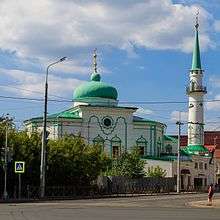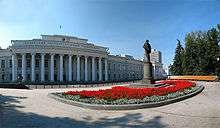Kazan
| Kazan (English) Казань (Russian) Казан (Tatar) | |
|---|---|
|
- City[1] - City of republic significance[1] | |
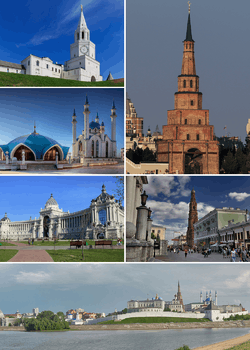 Left to right, top to bottom: Spasskaya Tower; Söyembikä Tower; Qol Sharif Mosque; Farmers' Palace; Epiphany Cathedral; View of Kazan | |
.svg.png) Location of the Republic of Tatarstan in Russia | |
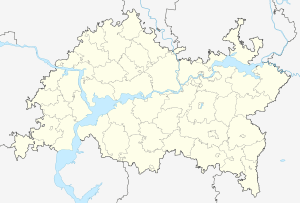 Kazan | |
|
| |
.svg.png) |
|
|
| |
| City Day | August 30[2] |
| Administrative status (as of February 2014) | |
| Country | Russia |
| Federal subject | Republic of Tatarstan[1] |
| Administratively subordinated to | city of republic significance of Kazan[1] |
| Capital of | Republic of Tatarstan |
| Administrative center of | city of republic significance of Kazan[1] |
| Municipal status (as of January 2012) | |
| Urban okrug | Kazan Urban Okrug[3] |
| Administrative center of | Kazan Urban Okrug[3] |
| Mayor[4] | Ilsur Metshin[4] |
| Representative body | City Duma[5] |
| Statistics | |
| Area | 425.3 km2 (164.2 sq mi)[6] |
| Population (2010 Census) | 1,143,535 inhabitants[7] |
| - Rank in 2010 | 8th |
| Population (2016 est.) | 1,216,965 inhabitants[8] |
| Density | 2,689/km2 (6,960/sq mi)[9] |
| Time zone | MSK (UTC+03:00)[10] |
| Founded | 1005[11] (see text) |
| Postal code(s)[12] | 420xxx |
| Dialing code(s) | +7 843[13] |
|
| |
| Kazan on Wikimedia Commons | |
Kazan (Russian: Каза́нь; IPA: [kɐˈzanʲ]; Tatar: Казан, Qazan) is the capital and largest city of the Republic of Tatarstan, Russia. With a population of 1,143,535, it is the eighth most populous city in Russia.[7] Kazan lies at the confluence of the Volga and Kazanka Rivers in European Russia. The Kazan Kremlin is a World Heritage Site.
In April 2009, the Russian Patent Office granted Kazan the right to brand itself as the "Third Capital" of Russia.[14] In 2009 it was chosen as the "Sports capital of Russia"[15] and it still is referred to as such.[16] The city hosted the 2013 Summer Universiade, 2014 World Fencing Championships, the 2015 World Aquatics Championships, and is one of the host cities for the 2017 FIFA Confederations Cup and the 2018 FIFA World Cup.
In 2015, Kazan was visited by 2.1 million tourists, which is a 20% increase in comparison with 2014. The Kazan Kremlin was visited by 1.5 million tourists in 2015 and hotel and entertainment complex with aquapark called "Kazan Riviera" was visited by 1 million tourists.[17]
Etymology
The origin of the name Kazan is uncertain. The most accepted legends derive it from the Bulgar (and also modern Tatar) word qazan, which means 'boiler' or 'cauldron'. One legend claims that the city was named after the river Kazanka, which was named after the son of a Bulgar governor dropped a copper cauldron into it.[18] Other local legends, including research by the Tatar scholar Shigabetdin Marjani, claim that the city was named for the resemblance of the hill on which it sits to an upturned cauldron.
History
Middle Ages
There is a long-running dispute as to whether Kazan was founded by the Volga Bulgars in the early Middle Ages or by the Tatars of the Golden Horde in the mid-15th century, as written records before the latter period are sparse. If there was a Bulgar city on the site, estimates of the date of its foundation range from the early 11th century to the late 13th century (see Iske Qazan). It was a border post between Volga Bulgaria and two Finnic tribes, the Mari and the Udmurt. Another vexatious question is where the citadel was built originally. Archaeological explorations have produced evidence of urban settlement in three parts of the modern city: in the Kremlin; in Bişbalta at the site of the modern Zilantaw monastery; and near the Qaban lake. The oldest of these seems to be the Kremlin.
If Kazan existed in the 11th and 12th centuries, it could have been a stop on a Volga trade route from Scandinavia to Baghdad. It was a trade center, and possibly a major city for Bulgar settlers in the Kazan region, although their capital was further south at the city of Bolğar.
After the Mongols devastated the Bolğar and Bilär areas in the 13th century, either the surviving Bulgars recuperated in numbers and were assimilated by a small number of Kipchaks from whom they adopted their language (a position known as Bulgarism), or Kipchaks and Bulgars intermixed to create the modern Kazan Tatar population. Kazan became a center of a duchy which was a dependency of the Golden Horde. Two centuries later, in the 1430s, Kipchak descendants of Genghis Khan, such as Ghiasetdin of Kazan, usurped power from its Bolghar dynasty.
Some Tatars also went to Lithuania, brought by Vytautas the Great.
In 1438, after the destruction of the Golden Horde, Kazan became the capital of the powerful Khanate of Kazan. The city bazaar, Taş Ayaq (Stone Leg) became the most important trade center in the region, especially for furniture. Craft-based manufacturing also thrived, as the city gained a reputation for its leather and gold goods, as well as for the opulence of its palaces and mosques. The citadel and Bolaq channel were reconstructed, giving the city a strong defensive capacity. The Russians managed to occupy the city briefly several times.
Russian Tsardom period
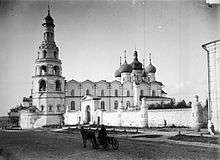
As a result of the Siege of Kazan in 1552, Russia under Ivan the Terrible conquered the city and massacred the majority of the population.[19] During the subsequent governorship of Alexander Gorbatyi-Shuisky, most of the khanate's Tatar residents were killed or forcibly Christianized, the Kerashen Tatars.[19] Mosques and palaces were ruined.[19] The surviving Tatar population was moved to a place 50 kilometers (31 mi) away from the city and this place was forcibly settled by Russian farmers and soldiers. Tatars in the Russian service were settled in the Tatar Bistäse settlement near the city's wall. Later Tatar merchants and handicraft masters also settled there. During this period, Kazan was largely destroyed as a result of several great fires. After one of them in 1579, the icon Our Lady of Kazan was discovered in the city.
In the early 17th century, at the beginning of the Time of Troubles in Russia, the Tsardom of Kazan declared independence with the help of the Russian population, but this independence was suppressed by Kuzma Minin in 1612.
Russian Empire period
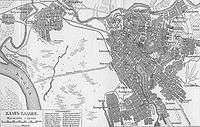
In 1708, the Tsardom of Kazan was abolished, and Kazan became the seat of Kazan Governorate. After Peter the Great's visit, the city became a center of shipbuilding for the Caspian fleet. The major Russian poet Gavrila Derzhavin was born in Kazan in 1743, the son of a poor country squire of Tatar ancestry though himself having a thoroughly Russian identity.
Kazan was largely destroyed in 1774 as a result of the Pugachev revolt (1774–1776), an uprising by border troops and peasants led by the Don Cossack ataman (Captain) Yemelyan Pugachev, but the city, formerly largely of timber construction, was soon afterwards rebuilt, using stone and according to a grid pattern plan, during the reign of Catherine the Great. Catherine also decreed that mosques could again be built in Kazan, the first being Marjani Mosque.
At the beginning of the 19th century Kazan State University and printing press were founded by Alexander I. It became an important center for Oriental Studies in Russia. The Qur'an was first printed in Kazan in 1801. Kazan became an industrial center and peasants migrated there to join its industrial workforce. In 1875, a horse tramway appeared; 1899 saw the installation of a tramway. After the Russian Revolution of 1905, Tatars were allowed to revive Kazan as a Tatar cultural center. The first Tatar theater and the first Tatar newspaper appeared.
Soviet period
In 1917 Kazan became one of the revolution centers. In 1918, Kazan was the capital of the Idel-Ural State, which was suppressed by the Bolshevist government. In the Kazan Operation of August 1918, it was briefly occupied by Czechoslovak Legions. In 1920 Kazan became the center of Tatar Autonomous Soviet Socialist Republic. In the 1920s and 1930s, most of the city's mosques and churches were destroyed, as occurred elsewhere in the USSR. During World War II, many industrial plants and factories to the west were relocated in Kazan, making the city a center of the military industry, producing tanks and planes. After the war Kazan consolidated as an industrial and scientific center. In 1979, the city's population reached one million.
Modern period

In the late 1980s and in the 1990s, after the dissolution of the Soviet Union, Kazan again became the center of Tatar culture and identity, and separatist tendencies intensified. With the return of capitalism, Kazan became one of the most important centers of the Russian Federation. The city went from 10th to 8th position in population ranking of Russian cities. In the late 2000s, the city earned the right to host both the 2013 Summer Universiade and 2018 FIFA World Cup.
Millennium of Kazan
Since 2000, the city has been undergoing a total renovation. The historical center—including the Kremlin—has been rebuilt, however a large number of the city's historical districts were completely demolished in the renovation. Kazan celebrated its millennium in 2005, after a city-organized historical commission settled on 1005 as the official year of the city's founding.[11] During the millennium celebrations, one of the largest mosque in Russia, Qolsharif, was dedicated in the Kazan Kremlin, the holiest copy of Our Lady of Kazan was returned to the city, the "Millennium Bridge" was inaugurated that year,[20] and the Kazan Metro began operation. The government of the Russian Federation released the Medal "In Commemoration of the 1000th Anniversary of Kazan". In 2010, for the preparations to the 2013 Universiade, Kazan began even more renovation by modernizing its airport, fixing the streets, enhancing public transport, and adopting Russian, English, and Tatar languages in all transportation, large stores, and shopping centers.
Administrative and municipal status
Kazan is the capital of the republic. Within the framework of administrative divisions, it is incorporated as the city of republic significance of Kazan—an administrative unit with the status equal to that of the districts.[1] As a municipal division, the city of republic significance of Kazan is incorporated as Kazan Urban Okrug.[3]
City divisions

Kazan is divided into seven districts:
| No. | District | Population[7] | Area (km²) |
|---|---|---|---|
| 1 | Aviastroitelny | 111,405 | 38.91 |
| 2 | Vakhitovsky | 86,202 | 25.82 |
| 3 | Kirovsky | 109,125 | 108.79 |
| 4 | Moskovsky | 130,537 | 38.81 |
| 5 | Novo-Savinovsky | 202,997 | 20.66 |
| 6 | Privolzhsky | 227,755 | 115.77 |
| 7 | Sovetsky | 275,514 | 167.00 |
Economy
Kazan is one of the largest industrial and financial centers of Russia, and a leading city of the Volga economic region in construction and accumulated investment.[21] City's Gross Regional Product had reached 380 billion rubles in 2011.(RUS) Казань побила рекорд по инвестициям
Total banking capital of Kazan banks is third in Russia. The main industries of the city are: mechanical engineering, chemical, petrochemical, light and food industries. An innovative economy is represented by the largest IT-park in Russia which is one of the largest of its kind among Eastern Europe science parks.[22][23] Kazan ranks 174th (highest in Russia) in Mercer’s Worldwide Quality of Living Survey.[24]
Investments
In 2011 city organisations and businesses attract more than 87 billion rubles for economy and social sphere development. This is 44% more than 2010 number. In 2014 businesses attracts 86 billion rubles. Most of them have been implemented in real economy sector.
Because of unstable economic situation within the country, there is a decrease of investment rates in 2015 and according to the statistics of the first part of the year it composed 51684.2 million rubles.
There are head offices of 6 companies that are in rating of top-500 in terms of revenues in Russia. Total square of city business centres is 330 thousand square metres.
Innovative economy in Kazan is represented by the biggest IT-park in Russia and also the biggest technical park in Europe. The only one online platform for governmental trade except the Moscow one is operated in Kazan. During post-soviet period Kazan was the leader in terms of house construction in Volga region and now it holds the position and implement Republican program of liquidation of dilapidated housing which was unique for Russia.
According to Forbes, Kazan has a 15th place in "Best cities for business in Russia" rating of 2010.[25] Then in 2012 Kazan gets a 6th place in Quality of city environment rating, which is made by Russian Federation Ministry of Regional Development, Russian Alliance of Engineers, Federal Construction Agency, Federal Service of Supervision of Consumer Protection and Welfare and Moscow Federal University.[26]
Transportation
Kazan International Airport
.jpg)
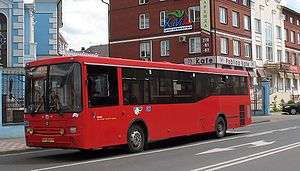
Kazan International Airport is located 26 kilometers (16 mi) from the city center. It is a hub for Tatarstan Airlines and Kazan Air Enterprise and hosts eleven air companies. Airport is connected with city by bus route #97.
There is also the Kazan Borisoglebskoye airfield, home to Kazan Aircraft Production Association, a major aircraft factory, famous in the past as "Aircraft Plant 22" ("22nd Zavod").
Adjacent to it lies a huge aircraft engines plant ("16th Zavod"). It produces versions of Tupolev 204 and 214 aircraft. In the past an Ilyushin-62, four-engine Russian mainliner, Tupolev-160 "Black Jack" supersonic strategic bomber and Tu-22M tactic bomber were also produced here. Both these plants and adjacent workers' housing make a whole city district known as "Aviastroitelny" ("Aircraft Builders").
Railways
Kazan is connected with Moscow, Ulyanovsk, Yoshkar-Ola and Yekaterinburg by train.
The main railway station Kazan–Passazhirskaya is located in the city centre and includes a main building (built in 1896), a commuter trains terminal, a ticket office building and some other technical buildings. Station serves thirty-six intercity trains and more than eight million passengers per annum.[27] The second terminus called "Kazan-2" is situated in the northern part of the city. Kazan also has nineteen platforms for commuter trains.
Riverside station
This station serves intercity ships and commuter boats. Pneumocushion boats are used in winter. Daily passenger turnover reaches 6 thousand.
Bus stations
There are two bus stations in Kazan—Central and Southern. Bus routes connect Kazan with all districts of Tatarstan, Samara, Ufa, Tolyatti, Orenburg, Ulyanovsk, Cheboksary, Sterlitamak, Buzuluk, Baki, and Aktobe. It is planned to build new stations in the East, West and North districts instead of Central for relieving city centre.
Highways
There are federal highway connections to Moscow and Ufa (E-22), Orenburg (R-239), Ul'yanovsk (R-241) and Igra (R-242). There are also R-175 federal highway and "Northern Europe — Western China" (in construction) route near the city.
There are five bridges across the Kazanka (Qazansu) river in the city, and one bridge connecting Kazan with the opposite bank of the Volga.
Public transit
- A single-line Kazan Metro, the north-southeast Central Line, opened on 27 August 2005. The Kazan Metro has seven stations, but there are plans to extend the line in both directions and is due to cross the Kazanka river with the stations "Dekabristov", "Moskovskaya", "Aviastroitel'naya" in 2012. Single trip costs 20 rub.
- The Kazan tram system was founded in 1899. 8 routes use 187 km (116.20 mi) of lines and 197 tramcars.[28] Single trip costs 20 rub. Rolling stock: LM-99, 71-608, 71-605.
- The Kazan trolleybus (electric bus) system was founded in 1948. 355 km (220.59 mi) of lines are used for 14 routes.[29] Single trip costs 20 rub. Vehicles: ZIU-682, Trolza-5275-05 "Optima", VMZ-5298.01-50 "Avangard".
- The Kazan bus system was totally renovated in 2007. 91 routes have an aggregate length of 1,981 km (1,231 mi). All 1,444 buses are colored red. Single trip costs 20 rub. Unlike in most Western cities, public bus routes are not municipal, operated by private companies and therefore are very efficient. Most of buses are imported, produced by "Golden Dragon", "Higer", "NefAZ", "MAZ", "Yutong", "Hyundai", "Bogdan"
- Travel cards that work within the metropolitan area reduce travel to 15 rub on trolley buses and buses, and offer considerable discounts on the metro line. These travel cards can be purchased from the post office.
- On July 1, 2013 the Veli'k bicycle sharing system was launched in Kazan. The system includes 7 self-service bicycle docking stations distributed throughout the centre of Kazan near the most popular city destinations, and 100 bikes. The service is open to everyone from 16 years of age. To access the service, you have to complete a simple sign-up procedure at www.Veli-k.ru, and buy a subscription for a suitable period of time. The first 30 minutes of every journey is free of charge. After the first half-hour, a service charge applies.
 MAZ-103 low-entry bus
MAZ-103 low-entry bus Trolza-5275 low-entry trolleybus
Trolza-5275 low-entry trolleybus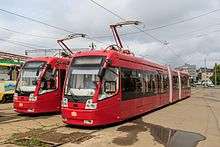 AKSM 843 tram
AKSM 843 tram_(6862165313).jpg) Metro
Metro
Demographics
Population
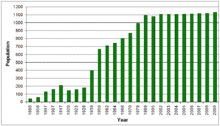
Population: 1,143,535 (2010 Census);[7] 1,105,289 (2002 Census);[30] 1,094,378 (1989 Census).[31] Kazan metropolitan area's population is 1.65 mln.
Rating of city population as on 1 January 2015
|
Place in the World |
Place in Europe |
Place in Former USSR |
Place in Russia |
Place in region |
|
24 |
13 |
6 |
1 |
| Year | Population |
|---|---|
| 1550 | 50,000 |
| 1557 | 7,000 |
| 1800 | 40,000 |
| 1830 | 43,900 |
| 1839 | 51,600 |
| 1859 | 60,600 |
| 1862 | 63,100 |
| 1883 | 140,000 |
| 1897 | 130,000 |
| 1917 | 206,600 |
| 1926 | 179,000 |
| 1939 | 398,000 |
| 1959 | 667,000 |
| 1979 | 989,000 |
| 1989 | 1,094,378 (census) |
| 1997 | 1,076,000 |
| 2000 | 1,089,500 |
| 2002 | 1,105,289 (census) |
| 2008 | 1,120,200 |
| 2009 | 1,130,717 |
| 2010 | 1,143,535 (census) |
| 2016 | 1,216,965 |
Ethnicity
The city's population consists mostly of ethnic Russians (48.6%) and ethnic Tatars (47.6%). The other ethnicities are Chuvash, Ukrainians, Azerbaijanis, Vietnamese,[32][33][34] and Jews.[35]
Religion
Predominant faiths of Kazan city are Sunni Islam and Orthodox Christianity, with Roman Catholicism, Protestantism, Judaism and the Bahá'í Faith also represented.
Languages
Tatar and Russian languages are widely spoken in the city. Russian is understood by everyone except for some older Tatars. Tatar is widely spoken mainly by Tatars.
Climate
Kazan has a humid continental climate (Köppen climate classification Dfb) with long, cold winters (colder than Moscow), and warm, often dry summers. As a result of its far inland position, summers are extremely warm for its latitude and winters are quite cold compared to areas further west in Europe.
The warmest month is July with daily mean temperature near 20.2 °C (68.4 °F), and the coldest month is January, with a daily mean of −10.4 °C (13.3 °F).
The city set its two hottest days on record during the 2010 Northern Hemisphere summer heat waves. Temperatures reached +39 °C (102 °F) in the hottest days during that time.
| Climate data for Kazan | |||||||||||||
|---|---|---|---|---|---|---|---|---|---|---|---|---|---|
| Month | Jan | Feb | Mar | Apr | May | Jun | Jul | Aug | Sep | Oct | Nov | Dec | Year |
| Record high °C (°F) | 4.5 (40.1) |
5.2 (41.4) |
14.0 (57.2) |
29.5 (85.1) |
33.5 (92.3) |
37.5 (99.5) |
38.9 (102) |
39.0 (102.2) |
32.3 (90.1) |
23.4 (74.1) |
15.0 (59) |
6.1 (43) |
39.0 (102.2) |
| Average high °C (°F) | −7.2 (19) |
−6.7 (19.9) |
−0.2 (31.6) |
10.2 (50.4) |
19.0 (66.2) |
23.6 (74.5) |
25.5 (77.9) |
22.9 (73.2) |
16.3 (61.3) |
8.1 (46.6) |
−1.0 (30.2) |
−5.8 (21.6) |
8.7 (47.7) |
| Daily mean °C (°F) | −10.4 (13.3) |
−10.1 (13.8) |
−3.9 (25) |
5.5 (41.9) |
13.3 (55.9) |
18.1 (64.6) |
20.2 (68.4) |
17.6 (63.7) |
11.7 (53.1) |
4.8 (40.6) |
−3.4 (25.9) |
−8.6 (16.5) |
4.6 (40.3) |
| Average low °C (°F) | −13.5 (7.7) |
−13.3 (8.1) |
−7.2 (19) |
1.7 (35.1) |
8.3 (46.9) |
13.4 (56.1) |
15.5 (59.9) |
13.3 (55.9) |
8.2 (46.8) |
2.2 (36) |
−5.6 (21.9) |
−11.4 (11.5) |
1.0 (33.8) |
| Record low °C (°F) | −46.8 (−52.2) |
−39.9 (−39.8) |
−31.7 (−25.1) |
−25.6 (−14.1) |
−6.5 (20.3) |
−1.4 (29.5) |
2.6 (36.7) |
1.6 (34.9) |
−5.4 (22.3) |
−23.4 (−10.1) |
−36.6 (−33.9) |
−43.9 (−47) |
−46.8 (−52.2) |
| Average precipitation mm (inches) | 41 (1.61) |
34 (1.34) |
33 (1.3) |
30 (1.18) |
41 (1.61) |
63 (2.48) |
67 (2.64) |
59 (2.32) |
52 (2.05) |
53 (2.09) |
46 (1.81) |
43 (1.69) |
562 (22.13) |
| Average rainy days | 3 | 2 | 4 | 11 | 15 | 18 | 16 | 16 | 18 | 17 | 10 | 5 | 135 |
| Average snowy days | 26 | 22 | 16 | 6 | 1 | 0 | 0 | 0 | 1 | 7 | 20 | 24 | 123 |
| Average relative humidity (%) | 84 | 80 | 76 | 67 | 58 | 65 | 68 | 70 | 75 | 80 | 85 | 84 | 74 |
| Mean monthly sunshine hours | 49 | 89 | 150 | 205 | 282 | 293 | 291 | 254 | 160 | 84 | 41 | 33 | 1,931 |
| Source #1: Pogoda.ru.net[36] | |||||||||||||
| Source #2: NOAA (sun, 1961–1990)[37] | |||||||||||||
Central Kazan
Kremlin
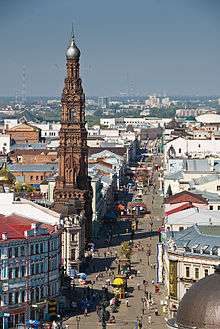
The city has a citadel (Russian: кремль, tr. kreml', or sometimes Tatar: kirman), which was declared a World Heritage Site in 2000. Major monuments in the kremlin are the five-domed six-columned Annunciation Cathedral (1561–62) and the mysterious leaning Soyembika Tower, named after the last queen of Kazan and regarded as the city's most conspicuous landmark.
Also of interest are the towers and walls, erected in the 16th and 17th centuries but later reconstructed; the Qol-Şarif mosque, which is already rebuilt inside the citadel; remains of the Saviour Monastery (its splendid 16th-century cathedral having been demolished by the Bolsheviks) with the Spasskaya Tower; and the Governor's House (1843–53), designed by Konstantin Thon, now the Palace of the President of Tatarstan.
Next door, the ornate baroque Sts-Peter-and-Paul's Cathedral on Qawi Nacmi Street and Marcani mosque on Qayum Nasiri Street date back to the 18th century.
Bistä, or Posad
Central Kazan is divided into two districts by the Bolaq canal and Lake Qaban. The first district (Qazan Bistäse or Kazanskiy Posad), historically Russian, is situated on the hill, the second (İske Tatar Bistäse or Staro-Tatarskaya Sloboda), historically Tatar, is situated between the Bolaq and the Volga. Mosques, such as Nurullah, Soltan, Bornay, Apanay, Äcem, Märcani, İske Taş, Zäñgär are in the Tatar district. Churches, such as Blagoveschenskaya, Varvarinskaya, Nikol'skaya, Tikhvinskaya, are mostly in the Russian part of the city. The main city-centre streets are Bauman, Kremlyovskaya, Dzerzhinsky, Tuqay, Puşkin, Butlerov, Gorkiy, Karl Marx and Märcani.
An old legend says that in 1552, before the Russian invasion, wealthy Tatars (baylar) hid gold and silver in Lake Qaban.
Wooden Kazan
In the beginning of the 1900s most of Central Kazan was covered by wooden buildings, usually consisting of two floors. There was a historical environment of Kazan citizens, but not the best place to live in. During the Republican program "The liquidation of ramshackle apartments" most of them (unlike other Russian cities), especially in Central Kazan, where the land is not cheap, were destroyed and their population was moved to new areas at the suburb of the city (Azino, Azino-2, Quartal 39). Nearly 100,000 citizens resettled by this programme.
Other major buildings
Another significant building in central Kazan is the former "Smolentzev and Shmelev" tea house and hotel, now the Shalyapin Palace Hotel. It is located at 7/80 Universitetskaya Street, at the corner of Universitetskaya and Bauman. A major landmark of late-19th and early-20th century commercial architecture, it consists of two portions. The original portion, built for a merchant named Usmanov in the 1860s, was bought by the inter-related families of Efim Smolentzev and Pavel and Nikolai Shmelev in 1899.[38] They operated a store selling, among other things, tea. In 1910, the Smolentevs and Shmelevs constructed another portion, designed by architect Vasili Trifonov, and operated a hotel there.[39] After the Russian Revolution, the building eventually became the Hotel Soviet and after 2000 it was heavily renovated to reopen as the Shalyapin Palace Hotel.
Cityscape



Education and science
Primary and secondary education
Primary and secondary education system of Kazan includes:
- 282 nurseries, most of which are municipal
- 178 schools, 2 of which are private
- 28 vocational technical schools
- 15 colleges
- 10 special colleges
There are also 49 music schools, 43 sports school, and 10 fine-arts schools, including the Kazan Art School founded in 1895.
Higher education
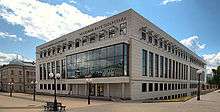
There are 44 institutes of higher education in Kazan, including 19 branches of universities from other cities. More than 140,000 students are educated in the city. Kazan Federal University (founded in 1804) is third oldest university in Russia after Saint Petersburg State University (1724) and Moscow State University (1755). In 2009 KFU got Federal status as main university of Volga Region. Some other prominent universities are:
- Kazan State Technical University – founded in 1932. In 2009 it got status of National university
- Kazan State Medical University – founded in 1814 as a department within Kazan State University
- Kazan State Technological University – founded in 1919 on the base of pre-existing vocational school
- Kazan State Conservatory – founded in 1945
- Volga Region State Academy of Physical Culture, Sport and Tourism - founded in July, 2010 in the framework of the XXVII World Summer Universiade Legacy. The branch, located in Naberezhnye Chelny, will proceed functioning.
Science
Kazan is a major scientific centre in Russia. Kazan formed a big number of scientific areas and schools (mathematical, chemical, medical, linguistic, geological, geobotanical, etc.). Scientific discoveries are a subject of special pride, including: the creation of non-Euclidean geometry (Nikolai Lobachevsky), the discovery of the chemical element ruthenium (Claus), the theory about the structure of organic compounds (Aleksandr Butlerov), the discovery of the electron paramagnetic resonance (Yevgeny Zavoisky) and acoustic paramagnetic resonance (Altshuler) and many others. The city hosts:
- Kazan Science Centre of Russian Academy of Sciences, since 1945. It includes 5 academic institutions.
- Tatarstan Academy of Sciences, since 1991. It includes 7 local departments with 13 academic institutions (also, 21 organisations are under the guidance of TAS) and one branch in Ulyanovsk.[40]
Public health
1814 year is considered to be an official year of the beginning of scientific medicine in Kazan. Exactly at that time University Hospital was open. In 1930 Faculty of Medicine is separated from the Kazan Federal University and holds a lot of specialized hospitals under its patronage. Nowadays Kazan becomes the largest public health center in Russia. 120 medical organisations are operated in the city. Kazan Interregional clinical-diagnostic center is the largest in Volga region in cardiovascular and neurological diseases. The largest hospital in Kazan is Republican Clinical Hospital.
Government and administration
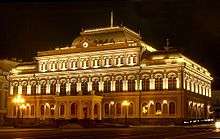
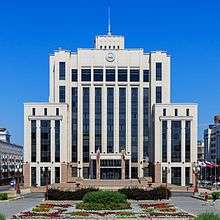
Mayor
İlsur Metşin became the mayor of Kazan in November 17, 2005.
City Duma
Kazan City Duma is a representative body of the city, elected every four years and holds its sessions in Kazan City Hall.
Executive committee
Executive committee is a municipal body of the executive organs . The committee's head is Denis Kalinkin.[41]
Government of the Republic of Tatarstan
Kazan hosts Tatarstan President's residence and administration (in Kremlin), Tatarstan's Cabinet of Ministers and Council of State (on Freedom square).
Sports
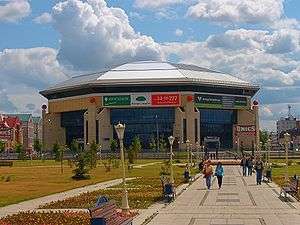
Kazan now is one of the most developed city in Russia in terms of sport. The city hosts two World Championships in Field Hockey in 2005 and 2011, World Summer Universiade 2013, World Championship in fencing in 2014, Aquatics Championship FINA 2015 and other international competitions of various levels. In future city will held 2017 FIFA Confederations Cup and 2018 FIFA World Cup.
City is a leader in terms of winnings in various sports including most popular teams sports.
Men's teams:
| Club | Sport | Founded | Current League | League Rank | Stadium |
|---|---|---|---|---|---|
| Rubin Kazan | Football | 1958 | Russian Premier League | 1st | Kazan Arena |
| Ak Bars Kazan | Ice Hockey | 1956 | Kontinental Hockey League | 1st | Tatneft Arena |
| Bars Kazan | Ice Hockey | 2009 | Minor Hockey League | Jr. 1st | Tatneft Arena |
| Irbis Kazan | Ice Hockey | 2011 | Minor Hockey League Division B | Jr. 2nd | Tatneft Arena |
| Dynamo Kazan | Bandy | 1958 | Bandy Super League | 1st | Raketa Stadium |
| UNICS Kazan | Basketball | 1991 | Professional Basketball League | 1st | Basket-Hall Arena |
| Zenit Kazan | Volleyball | 2000 | Volleyball Super League | 1st | Kazan Volleyball Centre |
| Sintez Kazan | Water Polo | 1974 | Water Polo Championship | 1st | Orgsintez |
Notable athletes
- Alexander Burmistrov, hockey player
- Viktor Kolotov, association football player
- Ruslan Nigmatullin, association football player
- Denis Arkhipov, hockey player
- Svetlana Demina, sport shooter
- Marat Safin, tennis player
- Dinara Safina, tennis player
- Alexander Fadeev, figure skater
Infrastructure
- Kazan Arena – stadium with capacity 45,000, home ground for FC Rubin
- Central stadium – Olympic stadium, capacity 30,133. Ex-home ground for FC Rubin.
- TatNeft Arena – indoor sporting arena, capacity 10,000. Home to HSC Aq Bars
- Basket-Hall – indoor sporting arena, capacity 7,000 (large hall) and 1,500 (small hall). Home to BC UNICS
- Kazan Volleyball Centre, capacity 4,600. Home to VC Zenit and WVC Dynamo-Kazan
- Raketa and Trudovye Rezervy ice stadiums
Important events
- 2019 WorldSkills Championship
- Kazan is the host city for the 2013 Summer Universiade, 2015 World Aquatics Championships, 2017 FIFA Confederations Cup and 2018 FIFA World Cup.
- 2016 – 28th International Olympiad in Informatics
- 2016 European Judo Championships
- 2014 European Badminton Championships
- 2011 European Weightlifting Championships
- 2005 and 2011 Bandy World Championship
- 2010 finswimming European championship
International relations
Branch offices of embassies
Consulates
Four consulates general are found in Kazan.[43]
-
 Consulate-General of Iran
Consulate-General of Iran -
 Consulate-General of Turkey
Consulate-General of Turkey -
 Consulate-General of Hungary
Consulate-General of Hungary -
 Consulate-General of Kazakhstan
Consulate-General of Kazakhstan
Visa centers
-
 Italian Visa Center in Kazan.[44]
Italian Visa Center in Kazan.[44] -
 Joint Visa Application Center of European Union for:
Joint Visa Application Center of European Union for:
Twin towns and sister cities
|
Kazan has also partner relations with the following cities and regions:
|
|
International organizations membership
- Organization of World Heritage Cities
- United Cities and Local Governments. Mayor of Kazan is a co-president of UCLG.
- Twin Cities International Association
- Historic Cities International Association
- General Conference of Mayors for Peace
- Organisation of Islamic Capitals and cities (observer)
- Metropolis
- International Assembly of capitals and large cities of CIS
Kazan has an Alliance française center.
Kazan has an American Corner.[48]
Notable people
- Rashid Nezhmetdinov, International Master and 5-time winner of the Russian Chess Championship
- Dayana Kirillova, singer who represented Russia at the Junior Eurovision Song Contest in 2013.
- Sofya Gulyak, Pianist, only female winner of The Leeds Piano Competition, in 2009.
References
Notes
- 1 2 3 4 5 6 Order #01-02/9
- ↑ Archived December 8, 2009, at the Wayback Machine.
- 1 2 3 Law #46-ZRT
- 1 2 Official website of the Mayor of Kazan (Russian)
- ↑ Official website of Kazan. Kazan City Duma (Russian)
- ↑ площадь собственно города, Федеральная служба государственной статистики
- 1 2 3 4 Russian Federal State Statistics Service (2011). "Всероссийская перепись населения 2010 года. Том 1" [2010 All-Russian Population Census, vol. 1]. Всероссийская перепись населения 2010 года (2010 All-Russia Population Census) (in Russian). Federal State Statistics Service. Retrieved June 29, 2012.
- ↑ Численность населения муниципальных образований Республики Татарстан
- ↑ The value of density was calculated automatically by dividing the 2010 Census population by the area specified in the infobox. Please note that this value may not be accurate as the area specified in the infobox does not necessarily correspond to the area of the entity proper or is reported for the same year as the population.
- ↑ Правительство Российской Федерации. Федеральный закон №107-ФЗ от 3 июня 2011 г. «Об исчислении времени», в ред. Федерального закона №271-ФЗ от 03 июля 2016 г. «О внесении изменений в Федеральный закон "Об исчислении времени"». Вступил в силу по истечении шестидесяти дней после дня официального опубликования (6 августа 2011 г.). Опубликован: "Российская газета", №120, 6 июня 2011 г. (Government of the Russian Federation. Federal Law #107-FZ of June 31, 2011 On Calculating Time, as amended by the Federal Law #271-FZ of July 03, 2016 On Amending Federal Law "On Calculating Time". Effective as of after sixty days following the day of the official publication.).
- 1 2 Шаймиев, Минтимер Шарипович; Камиль Исхаков; Мансур Х Хәсәнов (September 10, 1999). "Выступления Президента РТ М. Шаймиева, мэра г.Казани К.Исхакова и президента АН РТ, академика М.Хасанова на торжественном собрании по случаю установления даты основания г.Казани.". Гасырлар авазы/Эхо веков (3/4). Retrieved 2011-07-17.
- ↑ Kazan Russia — a thousand-year Russian city
- ↑ Current local time in Kazan
- ↑ "Kazan officially becomes Russia's Third Capital". Pravda. 2009-04-03. Retrieved 2013-03-26.
- ↑ Komsomolskaya Pravda: Kazan - sports capital of Russia 14.12.2009
- ↑ "List of Best Tatars". Mytopdozen.com. Retrieved 2013-03-26.
- ↑ "2,1 млн. туристов посетили Казань в 2015 году | www.tatar-inform.ru". tatar-inform.ru. Retrieved 2016-02-09.
- ↑ "InTourist Kazan'". Legends about Kazan's foundation. Retrieved 10 August 2012.
- 1 2 3 |url=https://translate.google.com/translate?hl=ru&sl=ru&tl=en&u=http%3A%2F%2Ftatarica.narod.ru%2Fcult%2Flibrary%2Fbook%2Fkazanhanligi%2Fchapter4.htm ХУДЯКОВ "Очерки по истории КАЗАНСКОГО ХАНСТВА"
- ↑ Putin joins Tatarstan festivities BBC News 2005-08-26
- ↑ Основные социально-экономические показатели городов 2008
- ↑ В строительство IT-парка вложили 3 миллиарда
- ↑ Инновационный технопарк Идея
- ↑ NZ cities excel in quality of living - Mercer worldwide survey finds
- ↑ "30 лучших городов для бизнеса — 2010". Forbes. Retrieved 2016-02-09.
- ↑ Мысько, Сергей Афанасьев, Влас. "Казань оценили на "6 с плюсом"". БИЗНЕС Online. Retrieved 2016-02-09.
- ↑ ГЖД в 2006 году больше всего пассажиров отправила со станции Горький-Московский
- ↑ Выступление А. К. Абдулхакова на аппаратном совещании 09.02.2009 «Об итогах работы городского пассажирского транспорта за 2008 год»
- ↑ В 2008 году в Казани всеми видами городского транспорта перевезено 319,9 млн пассажиров
- ↑ Russian Federal State Statistics Service (May 21, 2004). "Численность населения России, субъектов Российской Федерации в составе федеральных округов, районов, городских поселений, сельских населённых пунктов – районных центров и сельских населённых пунктов с населением 3 тысячи и более человек" [Population of Russia, Its Federal Districts, Federal Subjects, Districts, Urban Localities, Rural Localities—Administrative Centers, and Rural Localities with Population of Over 3,000] (XLS). Всероссийская перепись населения 2002 года [All-Russia Population Census of 2002] (in Russian). Retrieved August 9, 2014.
- ↑ Demoscope Weekly (1989). "Всесоюзная перепись населения 1989 г. Численность наличного населения союзных и автономных республик, автономных областей и округов, краёв, областей, районов, городских поселений и сёл-райцентров" [All Union Population Census of 1989: Present Population of Union and Autonomous Republics, Autonomous Oblasts and Okrugs, Krais, Oblasts, Districts, Urban Settlements, and Villages Serving as District Administrative Centers]. Всесоюзная перепись населения 1989 года [All-Union Population Census of 1989] (in Russian). Институт демографии Национального исследовательского университета: Высшая школа экономики [Institute of Demography at the National Research University: Higher School of Economics]. Retrieved August 9, 2014.
- ↑ Massive fire breaks out in Kazan market. Retrieved 2015-12-24.
- ↑ Funds raised to support Vietnamese people in Kazan. Retrieved 2015-12-24.
- ↑ Donation to Vietnamese people in Kazan. Retrieved 2015-12-24.
- ↑ (RUS) Новый облик Казани
- ↑ "Weather and Climate-The Climate of Kazan" (in Russian). Weather and Climate. Retrieved December 10, 2015.
- ↑ "Kazan Climate Normals 1961–1990". National Oceanic and Atmospheric Administration. Retrieved December 10, 2015.
- ↑ "ИЗДАНИЯ ЦБС "Прогулки по городу"". Retrieved 2008-02-20.
- ↑ "До тысячелетия Казани осталось 36 дней. Гостиница "Совет"". Retrieved 2008-02-20.
- ↑ Структура АНРТ
- ↑ http://old.kzn.ru/page21569.htm
- ↑ Embassy of Belarus
- ↑ Offices in Kazan
- ↑ Visa Management Service. Filiali
- ↑ Embassy of Finland
- ↑ Kazan City Committee for external relations and tourism
- ↑ "Braunschweigs Partner und Freundschaftsstädte" [Braunschweig - Partner and Friendship Cities]. Stadt Braunschweig [City of Braunschweig] (in German). Archived from the original on 2012-12-01. Retrieved 2013-08-07.
- ↑ "American Corners and Centers in Russia". Amcorners.ru. Retrieved 2013-03-26.
Sources
- Министерство юстиции Республики Татарстан. Приказ №01-02/9 от 4 февраля 2014 г. «Об утверждении реестра административно-территориальных единиц и населённых пунктов в Республике Татарстан», в ред. Приказа №01-02/160 от 11 марта 2015 г. «О внесении изменений в Приказ Министерства юстиции Республики Татарстан от 04.02.2014 №01-02/9 "Об утверждении реестра административно-территориальных единиц и населённых пунктов в Республике Татарстан"». Опубликован: Официальный сайт правовой информации Министерства юстиции Республики Татарстан (http://pravo.tatarstan.ru), 27 февраля 2014 г. (Ministry of Justice of the Republic of Tatarstan. Order #01-02/9 of February 4, 2014 On the Adoption of the Registry of the Administrative-Territorial Units and Inhabited Localities in the Republic of Tatarstan, as amended by the Order #01-02/160 of March 11, 2015 On Amending the Order of the Ministry of Justice of the Republic of Tatarstan #01-02/9 of February 4, 2014 "On the Adoption of the Registry of the Administrative-Territorial Units and Inhabited Localities in the Republic of Tatarstan". ).
- Государственный Совет Республики Татарстан. Закон №46-ЗРТ от 15 сентября 2004 г. «О границах территории и статусе муниципального образования города Казани», в ред. Закона №132-ЗРТ от 26 декабря 2014 г. «Об изменении границ территорий отдельных муниципальных образований и внесении изменений в Законы Республики Татарстан "О границах территории и статусе муниципального образования города Казани" и "Об установлении границ территорий и статусе муниципального образования "Лаишевский муниципальный район" и муниципальных образований в его составе"». Вступил в силу со дня официального опубликования. Опубликован: "Республика Татарстан", №191, 21 сентября 2004 г. (State Council of the Republic of Tatarstan. Law #46-ZRT of September 15, 2004 On the Borders of the Territory and the Status of the Municipal Formation of the City of Kazan, as amended by the Law #132-ZRT of December 26, 2014 On Changing the Borders of the Territories of Various Municipal Formations and on Amending the Laws of the Republic of Tatarstan "On the Borders of the Territory and the Status of the Municipal Formation of the City of Kazan" and "On Establishing the Borders of the Territories and the Status of the Municipal Formation of "Laishevsky Municipal District" and of the Municipal Formations It Comprises". Effective as of the official publication date.).
- Álvarez Veinguer, Aurora (July 2007). "(Re)Presenting Identities: National Archipelagos in Kazan". Nationalities Papers. 35 (3): 457–476. doi:10.1080/00905990701368704.
Further reading
- Smith-Peter, Susan (2016), "Enlightenment from the East: Early Nineteenth Century Russian Views of the East from Kazan University", Znanie. Ponimanie. Umenie, 13 (1): 318—338, doi:10.17805/zpu.2016.1.29, archived from the original on 5 May 2016, retrieved 5 May 2016.
External links
| Wikivoyage has a travel guide for Kazan. |
- Official website of Kazan
- Official website of Kazan (Russian)
- Kazan bird's-eye
- Kazan weekend guide
- Virtual Guide around Kazan
- The Kazan Times: Business and political news from Kazan, Tatarstan, Russia and all over the World
- Kazan city tourist portal
- Kazan millennium
- Universiade Kazan 2013
- Kazan 1000 years old
- The history of Islamic religion in Kazan
- Kazan - Global Stroll
- http://www.kazan-memory.uni-tuebingen.de/indexee.html – Student project about Kazan's history (central aspects: memory, religion)
- The architecture of Kazan (Russian)
- Russia - Republic of Tatarstan - Kazan - photo galleries
- Kazan Travels
